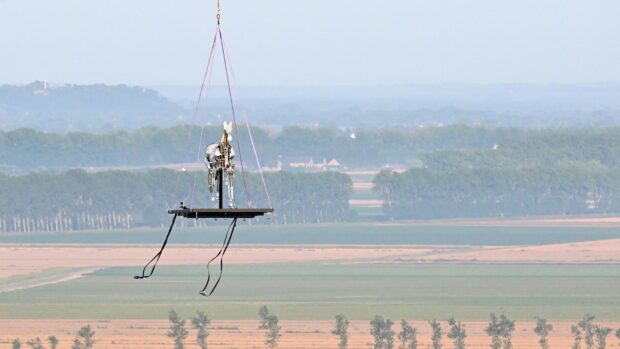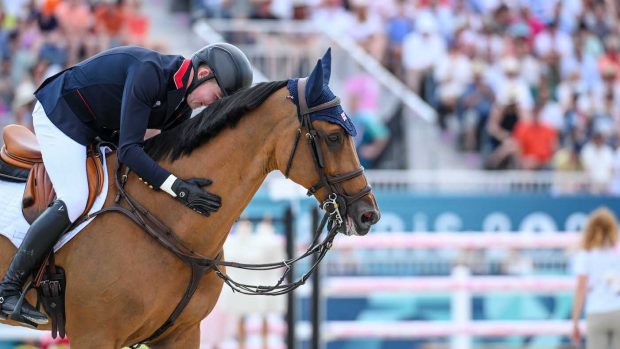What do we currently know about the 2024 Olympic cross-country course? Here is all the available information ahead of the Olympic Games in Paris this summer…
The course-designer
Pierre Le Goupil was named as the course-designer in February 2022 and describes it as “the job of a lifetime”. He comes from a horsey family, who run Le Grand Complet at Haras du Pin, and his father Andre rode at the 1968 Olympics in Mexico, finishing 12th individually.
Pierre has experience of designing courses around the world, including for the 2023 Pan American Games in Santiago, Chile, and the European Eventing Championships last year at Haras du Pin.
2024 Olympic cross-country course: the basics
The cross-country phase takes place on Sunday 28 July in the park of the palace of Versailles.
The rulebook stipulates that the track will be 5,000-5,800m long, with a maximum optimum time of 10 minutes and at most, 42 jumping efforts. Information released so far says the actual length will be 5,300m, with an optimum time of 9min 18sec.
The pontoon crossings
The course will feature two pontoon crossings over Versailles’ historic Grand Canal, which have been a major talking point in the build-up to the Games.
The Grand Canal, designed by André le Nôtre and built in the mid-17th century, was home to kings’ boats and used for skating during frozen winters.
The crossings were tried out as part of the two-day operational test event (22–23 August 2023). The rented pontoons feature a series of tanks, which are filled with water and sunk to an agreed level, with the structure anchored to the base of the canal. The surface has matting and sand footing for the horses to canter on.
“It’s a really interesting system and it proved to be incredibly stable,” said FEI games operations director Tim Hadaway after the test event, at which five members of the French youth eventing squad crossed the pontoon and jumped five fences.
The images of horses crossing the Grand Canal should be among the many spectacular pictures of horse sport at the Paris Olympics, which will hopefully help cement equestrianism’s place at the Games.
Operating on a historic site
Versailles is a UNESCO World Heritage Site and learnings have been taken from the London 2012 Olympics, as Greenwich is also a UNESCO World Heritage Site.
“Much like the project that we delivered in Greenwich Park, it’s obviously a very sensitive, well-used and much-loved environment. So the whole project is geared around solutions that minimise the impact both on the environment itself and on the users of the park as much as possible,” said Tim.
Versailles Palace president Catherine Pégard said after the test event: “The site must be restored just as it used to be – and I believe it will be even more beautiful, because we’ll have improved access and we’ll have worked to make the gardens even more attractive.
“It is a great pride to associate one of the symbols of French culture, one of the symbols of France, with these Games, which will be watched all over the world.”
Groundwork
Work on the going at Versailles started in the summer of 2022. This has included Mark Lucey and Professor Lars Roepstorff taking ground readings with testing devices and teaching the expert turf management team at Normandie Drainage how to use these, meaning they have continual access to objective data to help inform ground preparations.
Pierre’s Le Goupil’s philosophy
Pierre says designing in Versailles “is all about telling a story – we need to speak to the audience.”
He says the track “must be challenging enough and a true four-star question” and is aware of the fact that at the Olympics, a track must test the best as well as giving a good chance for those from less experienced eventing nations to finish.
Some combinations will offer a multitude of options.
“In some cases it won’t be necessarily direct routes versus slow routes, but more like multiple choice questions,” says Pierre, who adds that this will lead to riders having to make choices and anticipate unexpected situations, adding interest.
He has spoken also about the fact that Versailles is a “typical French public woodland”, with geometric layouts, passes and avenues, but that there will be a good proportion of natural fences, using ground undulation.
“Luckily, we’ve obtained the right to use a bit of the undergrowth and the reliefs (slopes and banks), and in some places to create what we need to make it very spectacular,” he says.
Pierre has used 3D imaging to show his designs as he plans, which has helped with obtaining permission to make his plans reality in this protected landscape as relevant people have been able to clearly visualise his suggestions.
In terms of safety and welfare, the 2024 Olympic cross-country course will contain frangible fences and planning has gone into the possibility of hot or very wet weather. The track is mostly in the shade, running under the “magnificent trees”, and the groundwork will prevent the going from becoming too deep.
You might also be interested in:

‘Spectacular, but fair’: inside the mind of the Paris Olympic course-designer

They don’t make ’em like they used to – a look back at the Olympics of yesteryear

Horses gallop across Versailles’ Grand Canal pontoon in ‘hugely exciting’ Paris Olympics test

Find somewhere to stay near Versailles for the Paris Olympics and Paralympics

Subscribe to Horse & Hound magazine today – and enjoy unlimited website access all year round
Horse & Hound magazine, out every Thursday, is packed with all the latest news and reports, as well as interviews, specials, nostalgia, vet and training advice. Find how you can enjoy the magazine delivered to your door every week, plus options to upgrade your subscription to access our online service that brings you breaking news and reports as well as other benefits.




